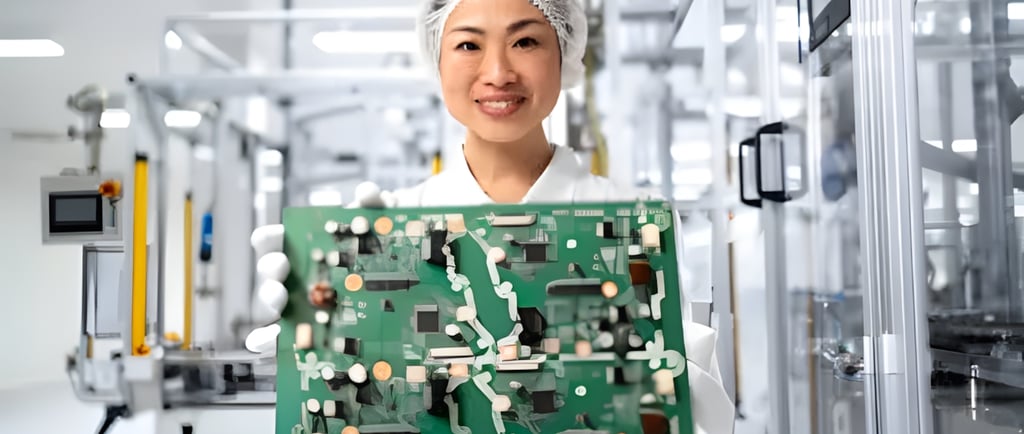Electronics Manufacturing Outsourcing: The Ultimate Guide to Cutting Costs and Scaling Innovation for Tech Leaders
Whether you’re a startup racing to prototype a wearable IoT device or an enterprise scaling smart home solutions, partnering with the right EMS provider can mean the difference between market dominance and obsolescence.
3/4/20253 min read


The global electronics manufacturing services (EMS) market is booming, projected to exceed $1 trillion by 2030, driven by relentless demand for smarter, smaller, and faster devices. For designers and decision-makers in electronics development, outsourcing isn’t just a trend—it’s a strategic lifeline. Whether you’re a startup racing to prototype a wearable IoT device or an enterprise scaling smart home solutions, partnering with the right EMS provider can mean the difference between market dominance and obsolescence.
But outsourcing isn’t without risks. From intellectual property (IP) leaks to quality control nightmares, the stakes are high. This guide dives deep into the why, how, and what-if of electronics manufacturing outsourcing, arming you with actionable insights to make informed, profitable decisions.
1. Understanding Electronics Manufacturing Outsourcing
What Does Outsourcing Really Mean in Electronics?
Electronics manufacturing outsourcing involves delegating part or all of your production process to third-party specialists. This could range from PCB assembly and surface-mount technology (SMT) to full-product lifecycle management.
Key Players in the Ecosystem
OEMs (Original Equipment Manufacturers): Companies like Apple or Samsung that design and sell products but may outsource manufacturing.
ODMs (Original Design Manufacturers): Partners like Foxconn that handle both design and production.
EMS Providers: Flex or Jabil, offering end-to-end services from prototyping to logistics.
Common Outsourced Processes
Prototyping and DFM (Design for Manufacturing) analysis.
Component sourcing and procurement.
PCB assembly, testing, and conformal coating.
Box-build assembly and global distribution.
2. Why Outsource? The Compelling Case for Tech Innovators
Cost Efficiency: Beyond Labor Savings
While labor arbitrage (e.g., manufacturing in Asia) cuts costs by 30–50%, smarter savings come from:
Bulk material purchasing discounts via EMS partners.
Avoiding capital expenditures on machinery like reflow ovens or AOI (Automated Optical Inspection) systems.
Reduced overhead (factory space, utilities, staffing).
Access to Cutting-Edge Expertise
Most EMS providers invest heavily in Industry 4.0 technologies:
AI-driven predictive maintenance to minimize downtime.
IoT-enabled supply chain tracking for real-time visibility.
Advanced PCB fabrication for high-density interconnect (HDI) designs.
Scalability: Pivot Without Pain
When demand spikes (e.g., during a chip shortage), EMS partners with multi-region facilities can reroute production swiftly. Conversely, downsizing avoids costly idle lines.
Focus on Core Innovation
By offloading production, your team can prioritize R&D for next-gen products—like refining edge computing devices or 5G modules.
Regulatory Compliance Made Easier
EMS providers navigate complex standards like RoHS, REACH, and FCC certification, reducing time-to-market delays.
3. Outsourcing Models: Finding Your Fit
OEM vs. ODM: Who Owns the Design?
OEM Model: Retain full control of your design but rely on the EMS partner for execution. Ideal for proprietary tech (e.g., medical devices).
ODM Model: The partner handles both design and manufacturing. Perfect for generic products (e.g., budget smartphones).
EMS Providers: The Full-Service Powerhouses
Top-tier EMS companies offer:
Design for Excellence (DFX) support to optimize manufacturability.
Supply chain resilience through dual-sourcing strategies.
Post-production services like warranty repairs or refurbishment.
Hybrid Models: Best of Both Worlds
Example: Keep high-margin assembly in-house (e.g., final firmware flashing) while outsourcing labor-intensive tasks (e.g., soldering).
4. Benefits: More Than Just Cost Savings
Faster Time-to-Market
Case Study: A Silicon Valley startup reduced prototyping time from 12 weeks to 3 by partnering with a Shenzhen EMS firm with rapid turnkey PCB assembly.
Risk Mitigation
Shared liability for compliance failures or recalls.
Diversified production hubs to counter geopolitical disruptions.
Sustainability Gains
Many EMS providers now offer:
Circular manufacturing (recycling e-waste into new components).
Carbon-neutral factories powered by renewables.
5. Challenges: Navigating the Minefield
Quality Control: Trust but Verify
Demand IPC-A-610 certification for assembly standards.
Use remote video audits to inspect production lines in real time.
IP Protection: Guard Your Crown Jewels
Implement hardware security modules (HSMs) for firmware encryption.
Draft ironclad NDAs with jurisdiction-specific penalties.
Hidden Costs: The Devil’s in the Details
Watch for tariff traps (e.g., Section 301 duties on Chinese imports).
Factor in logistics lead times and expedited shipping fees.
Communication Breakdowns
Insist on bilingual project managers.
Use tools like Slack or Microsoft Teams for daily updates.
6. Choosing the Right Partner: A Step-by-Step Playbook
Step 1: Define Your Needs
Are you outsourcing for cost, expertise, or speed?
Prioritize must-haves: ISO 13485 for medical devices or ITAR compliance for defense contracts.
Step 2: Vet Shortlisted Vendors
Site Visits: Inspect factory conditions and worker training.
Reference Checks: Ask past clients about on-time delivery rates.
Step 3: Negotiate Smart Contracts
Include penalty clauses for missed deadlines.
Clarify cost escalation terms for raw materials like copper or semiconductors.
7. Case Studies: Lessons from the Trenches
Success Story: How Startup X Slashed Costs by 40%
By outsourcing to a Mexican EMS provider, this IoT company avoided Chinese tariffs and cut shipping times to the U.S. market.
Cautionary Tale: The $2M IP Mistake
A robotics firm lost critical firmware code due to lax cybersecurity at a low-cost Asian vendor.
8. Future Trends: What’s Next in Outsourcing?
AI-Driven Factories: Machine learning algorithms predicting component failures.
Nearshoring Surge: Shifting production to Eastern Europe or Mexico post-pandemic.
Microfactories: Hyper-localized hubs for custom, small-batch orders.
Conclusion
Electronics manufacturing outsourcing isn’t a one-size-fits-all solution—it’s a strategic lever. For designers and decision-makers, the key lies in balancing cost, control, and innovation. By choosing partners aligned with your vision and rigorously managing risks, you can turn outsourcing into a competitive superpower.
